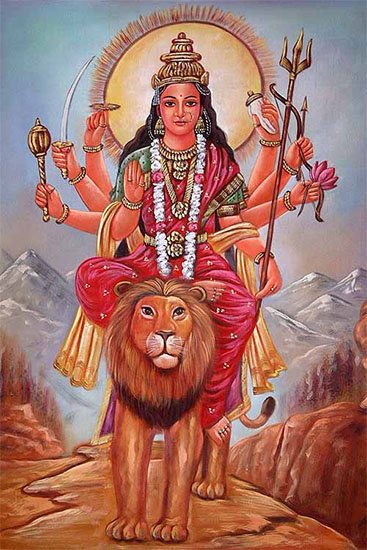Lajja is one of the five niyamas. These are rules that show how a sadhaka (spiritual disciple) should live their life and deal with issues regarding their inner Self.
Lajja means "shame" when translated into English. The basic concept is that the sadhaka should be ashamed only of the bad things in life, but not of the good things.
Lajjā (लज्जा, “modesty”):—One of the names attributed to Devī, as chanted by the Vedas in their hymns, who were at the time incarnated in their personified forms. See the Devī-bhāgavata-purāṇa chap
Lajjā (लज्जा) refers to “bashfulness”.—The Kubjikāmatatantra tell us that the goddess who emerges from the Liṅga is bent (kubjarūpā). Various reasons are given in the sources for her being ‘bent’. Some of these relate to her personal mythic identity. From this perspective, we are told a little further on in the text that she is bent with bashfulness (lajjā) when she sees Bhairava. Further ahead, after her marriage to the god, she is again ‘bent’.
Lajjā (लज्जा, “modesty”):—One of the twenty-four emanations of Lakṣmī accompanying Nārāyaṇa. This particular manifestation couples with his counterpart form called Dāmodara and together they form the twelfth celestial couple. Lakṣmī represents a form of the Goddess (Devī) as the wife of Viṣṇu, while Nārāyaṇa represents the personification of his creative energy, according to the Pāñcarātra literature.
Lajja, Lajjā: 24 definitions
Introduction:
Lajja means something in Hinduism, Sanskrit, Buddhism, Pali, Marathi, Jainism, Prakrit, Hindi. If you want to know the exact meaning, history, etymology or English translation of this term then check out the descriptions on this page. Add your comment or reference to a book if you want to contribute to this summary article.
In Hinduism
Shaktism (Shakta philosophy)
Lajjā (लज्जा, “modesty”):—One of the names attributed to Devī, as chanted by the Vedas in their hymns, who were at the time incarnated in their personified forms. See the Devī-bhāgavata-purāṇa chapter 5.51-68, called “the narrative of Hayagrīva”.
Source: Google Books: ManthanabhairavatantramLajjā (लज्जा) refers to “bashfulness”.—The Kubjikāmatatantra tell us that the goddess who emerges from the Liṅga is bent (kubjarūpā). Various reasons are given in the sources for her being ‘bent’. Some of these relate to her personal mythic identity. From this perspective, we are told a little further on in the text that she is bent with bashfulness (lajjā) when she sees Bhairava. Further ahead, after her marriage to the god, she is again ‘bent’.

Shakta (शाक्त, śākta) or Shaktism (śāktism) represents a tradition of Hinduism where the Goddess (Devi) is revered and worshipped. Shakta literature includes a range of scriptures, including various Agamas and Tantras, although its roots may be traced back to the Vedas.
Pancaratra (worship of Nārāyaṇa)
Lajjā (लज्जा, “modesty”):—One of the twenty-four emanations of Lakṣmī accompanying Nārāyaṇa. This particular manifestation couples with his counterpart form called Dāmodara and together they form the twelfth celestial couple. Lakṣmī represents a form of the Goddess (Devī) as the wife of Viṣṇu, while Nārāyaṇa represents the personification of his creative energy, according to the Pāñcarātra literature.

Pancaratra (पाञ्चरात्र, pāñcarātra) represents a tradition of Hinduism where Narayana is revered and worshipped. Closeley related to Vaishnavism, the Pancaratra literature includes various Agamas and tantras incorporating many Vaishnava philosophies.
Purana and Itihasa (epic history)
Lajja (लज्ज).—One of the thirteen daughters of Dakṣaprajāpati. The other daughters were, Śraddhā, Lakṣmī, etc. (Chapter 7, Aṃśa 1, Viṣṇu Purāṇa).
Source: archive.org: Shiva Purana - English Translation1) Lajjā (लज्जा, “bashfulness”) is one of the twenty-four daughters of Dakṣa by Prasūti: one of the three daughters of Svāyambhuvamanu and Śatarūpā, according to the Śivapurāṇa 2.1.16:—“Dakṣa begot twenty-four daughters. Thirteen daughters Śraddhā etc. were given to Dharma in marriage by Dakṣa. O lordly sage, listen to the names of Dharma’s wives. Their names are [... Lajjā (bashfulness),...]. Thereupon the entire universe consisting of three worlds, mobile and immobile was filled (with progeny). Thus according to their own actions and at the bidding of Śiva innumerable famous Brahmins were born out of the various living beings”.
2) Lajjā (लज्जा, “bashfulness”) refers to “bashful” or “shyness”, according to the Śivapurāṇa 2.2.19. Accordingly as Brahmā narrated to Nārada:—“[...] since she [viz., Satī] was bashful (lajjā) in the presence of Śiva I could not see her face. She did not show out her face on account of shyness (lajjā)”.
Source: Cologne Digital Sanskrit Dictionaries: The Purana Index1a) Lajjā (लज्जा).—A Śakti.*
1b) R. from Ṛṣyavān.*
1c) A daughter of Dakṣa;1 married Dharma;2 mother of Vinaya.3
Source: JatLand: List of Mahabharata people and placesLajjā (लज्जा) is a name mentioned in the Mahābhārata (cf. I.60.14) and represents one of the many proper names used for people and places. Note: The Mahābhārata (mentioning Lajjā) is a Sanskrit epic poem consisting of 100,000 ślokas (metrical verses) and is over 2000 years old.
No comments:
Post a Comment